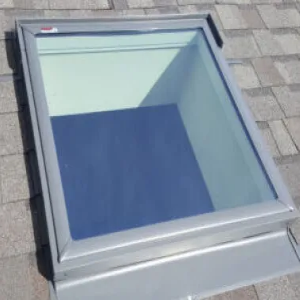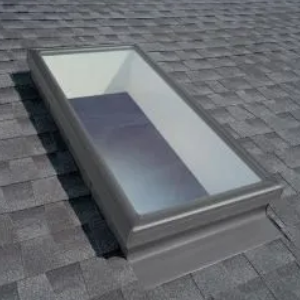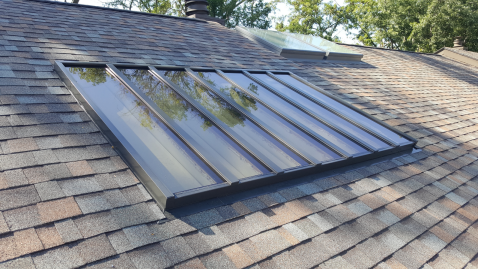Skylight FAQs
Q. What is the difference between a Deck mounted and a Curb mounted skylight
A. From the roof almost none…but these two types of skylights are designed to fill different needs. The deck-mounted skylight sits right down on the roof deck and the interior shaft extends into the skylight itself. This makes for a very finished look and is best for new installations on sloped roofs.
The curb-mounted units are more like a skylight cap that sits over a 2x4 or 2x6 curb or a 2x8 curb for flat roof installations. They are often used in retrofit situations where matching the exact size of an old unit is difficult or on flat roofs where the new skylight needs to be raised above the level of the roof deck. Custom size units can also be ordered.
Both of these skylights can be flashed with either the VELUX factory flashing kits (EDL or ECL) and both come in venting and non-venting models. VELUX also makes blinds and shades for almost all skylights, deck, or curb-mounted. However, shades are not available for custom size skylights.


Q. What does a new skylight cost?
A. VELUX skylights are not expensive in their basic form…but when you get into the venting units with shades or blinds, the price can go up considerably. That being said, a basic fixed skylight might cost $250 to $800 depending on size. Custom skylights can be a bit more. The largest fixed (non-venting) skylight we stock costs under $800…but upgrade to a manually venting unit and the price goes up about 20%, The electrically venting or solar units jump about $1000.00 just for the skylight…installation, flashing kits, shades or blinds and other materials, and taxes will easily double those amounts. Still, there is very little you can do for your house that makes such a difference at this price.
Q. We are considering adding a new skylight.
What advice do you have?
A. Placement and dimension are two very important considerations. Skylights should be situated so that they bring light (and ventilation) into areas that can use them. This sounds too simple but we often see skylights directly over a sitting area or in a media room where the skylight makes the television or computer screen hard to view. Kitchens and bathrooms really should have venting units if possible especially if a exhaust fan isn't installed. What seems like an obvious location from inside the house may present a whole different set of issues from the roof…ridges, valleys, and all sorts of obstacles may exist in the attic. The dimensions or size of a skylight is also an issue. What seems large right in front of you is often way too small 8 to 12 feet overhead. Be careful not to undersize the skylight…placing several units next to each other becomes very dramatic. Including the option to vent your new skylights is always something to consider, especially with the available 30 % solar tax credit on solar powered skylights.
Q. Why would I want a venting skylight?
A. When VELUX developed skylights and roof windows in Europe over 80 years ago, the concept was to open up unusable attic space by adding ventilation and light (VE + LUX = ventilation and light). Today In Europe you will seldom find a structure without skylights, and most are venting skylights, as opposed fixed (non-venting) skylights that are most common in the US. But why would you want venting?
- They provide ventilation especially well in high-humidity areas like kitchens and bathrooms effectively reducing the opportunity for condinsatiion and for mold and mildew to develop.
- They create a chimney effect to express the hot air up and out of your house like no other passive system can saving air conditioning cost by as much as 20%.
- They bring in fresh air to areas that need ventilation.
- A venting skylight can have a positive impact on you and your home.
- Venting Skylights as well as blinds can also be programmed to open or close at a specified time or at pre-determined interior conditions, IT can even open automatically if Co2 is detected with Velux Active and climate sensor, It will also automatically close in the event of bad weather.
Q. What is so special about a Solar-Powered Skylight?
A. Even though VELUX is the industry leader in skylights, they continue to create cutting-edge products like the Solar-powered "Fresh Air" skylight. This solar skylight requires no electricity as it gets all the energy it needs to open and close from the sun. The "smart batteries" limit the skylight so it will only open when there is sufficient charge to close it. And it closes automatically in the event of bad weather or if the battery charge reaches its low tolerance. But the best feature may be the 30% Federal Tax Credit which applies to the price of the skylight and any labor cost associated with installing it. That means that the price of a solar-powered venting skylight could be less expensive than a fixed unit after the tax credit.
Q. My skylight has condensation issues?
A. On older skylights the thermal glass was not nearly as efficient as the new VELUX LoE3 glazing. That being said, condensation is often the result of way too much humidity inside the house. In the winter when your living room is 70 degrees and the relative humidity may be properly set at 20%, the air up in the skylight shaft maybe 85 degrees and the humidity next to the glass could be 50% or more. There is little anyone can do to prevent condensation on older skylights in those circumstances. VELUX skylights are manufactured with small weep holes around the perimeter of the glass. After some years those holes, which are designed to allow condensation to escape, become clogged. A good vacuum cleaner can sometimes help clean out the weep holes and solve or reduce this issue. If the problem persists, the next best solution is to upgrade to a new VELUX thermally insulated skylight. Condensation is generally a winter-time problem however it often indicates that the thermal insulation in the skylight has failed to allow heat to leave the house. This often translates into complaints about too much heat coming from a skylight in the summertime. Again, the thermal insulation in an old skylight is gone allowing heat to radiate through the skylight. Read more about condensation here "When a leak isn't a leak"
Q. What is the cost to replace a failed skylight?
A. Generally, it costs between $1,250 to $3,200 to replace a failed skylight. This price includes the new skylight, the flashing kit, underlayment, shingles, and moderate repairs or re-trimming the interior light shaft. Sometimes a broken skylight or plastic (acrylic) bubble on a perfectly good curb can be replaced for Less. Remember that a leak around the skylight may not be the fault of the skylight. The skylight is often the most convenient place for water from a roof leak or chimney flashing to become visible inside the house.
Q. What is the VELUX No Leak Skylight?
A. In 2010 VELUX developed an entirely new line of skylights that features a No Leak Promise (visit www.thenoleakskylight.com for more information). These new designs from top to bottom skylights feature three layers of leak protection, an entirely new method of installation, pre-painted interior frames, argon gas and insulated LoE3 glass that provides more daylight with superior heat control. Properly installed these skylights are warranted by the manufacturer to be leak-free for the next ten years. And the new thermal-glass panels are warranted not to fail for the next twenty years.
Q. Why does The Skylight Guys
always use laminated-glass skylights?
- Laminated glass skylights have three panes of glass which increases strength and improves the UV protection
- In the US most Building codes for overhead applications require Laminated Glass, Nebraska is no execption. In fact, Velux stopped producing their deck mount units with only tempered glass in 2020.
- Laminated glass skylights are the only units that feature the new NEAT® Glass
- NEAT glass helps keep skylights spot-free with a special silicon dioxide coating that makes the glass surface extremely smooth causing water to sheet off the glass
- NEAT glass helps keep skylights clean with a special titanium dioxide coating that interacts with sunlight causing organic matter to breakdown so it will wash off with rainwater.
- Laminate glass is safer because of a clear membrane sandwiched between two panels of heat-treated glass, much like the windshield of your car
- Laminated glass is up to 25% quieter than tempered glass skylights and at least 50% quieter than a plastic skylight
Q. Don't Skylights always leak?
A. VELUX has been making skylights and roof windows for over 80 years and it's unlikely that they would still be in business if they produced a product that leaked. A properly installed skylight should be problem-free for many years and the VELUX 10 Year No Leak Warranty assures you of that.
We tell our customers "Skylights don't leak - but installations can". In fact, you would not believe the installations by other so called "skylight experts" we get called out to fix.
" We Don't install leaks"
Skylights are all we do, every installation we do will have a certified installer doing the work.
If you would like a leak installed, please call one of our competitors, a roofing company or a general contractor that hires out their work to the cheapest subcontractors they can find.
Q. What is the VELUX Warranty?
A. Each skylight and Sun Tunnel® made by VELUX which is properly installed is warranted for 10 years, The skylight glass is warranted for 20 years.
The Skylight Guys provides an honest, ten-year comprehensive residential installation warranty, a five-year commercial warranty and we are a....
VELUX Five-Star Certified Skylight Specialist, Wasco Certified Skylight Specialist for commercial Units and Sun-Tek Certified Skylight Specialist for their polycarbonate units.
Q. What are the most common reasons skylights
need to be replaced?
A. Age. We regularly replace skylights that have been on a roof for over 25 years. But we sometimes replace skylights that are less than 5 years old often because they were poorly installed. In fact, when a skylight isn't replaced during a roofing project, we are usually called out in as little as a year to replace it. Age is the most common reason to replace skylights, incompetent installation would be number two. VELUX skylights rarely fail…and when they do it's usually after a very long life.
Skylights fail in two ways…they deteriorate and begin to leak and/or they lose their thermal insulation and allow heat loss or heat gain. Just because your skylight isn't leaking doesn't mean it shouldn't be replaced. Skylights made ten or fifteen years ago just didn't have the technology to maintain their thermal insulation properties. Thermal heat gain or loss could cost hundreds of dollars per year.... per skylight.
Q. What can you do about a leaking skylight?
A. A significant portion of our business involves repairing or replacing old skylights. As a general rule, any skylight over ten years old is probably best replaced rather than spending money to try and have it repaired. Skylights for the most part are not terribly expensive, but the labor to have them properly repaired or replaced can be. For that reason, we often replace old skylights with new products that we can warrant to be leak-free for many years.
Q. What other types of work do you do?
A. Here at The Skylight Guys we specialize in skylights, and Sun Tunnels®, We are the oldest VELUX Five Star installation company in Nebraska.
We also service the Council Bluffs area, in fact we became certified the first year Velux implemented the program, no other firm sells and installs more skylights and sun tunnels than The Skylight Guys.
"I really just wanted to repair my old skylights, but
The Skylight Guys explained how that is often throwing good money after bad and
that we could qualify for a tax credit of 30% if we installed the right products.
What they said made sense and I'm glad I went with them.
They obviously know about skylights."
Jerry B - Lincoln


